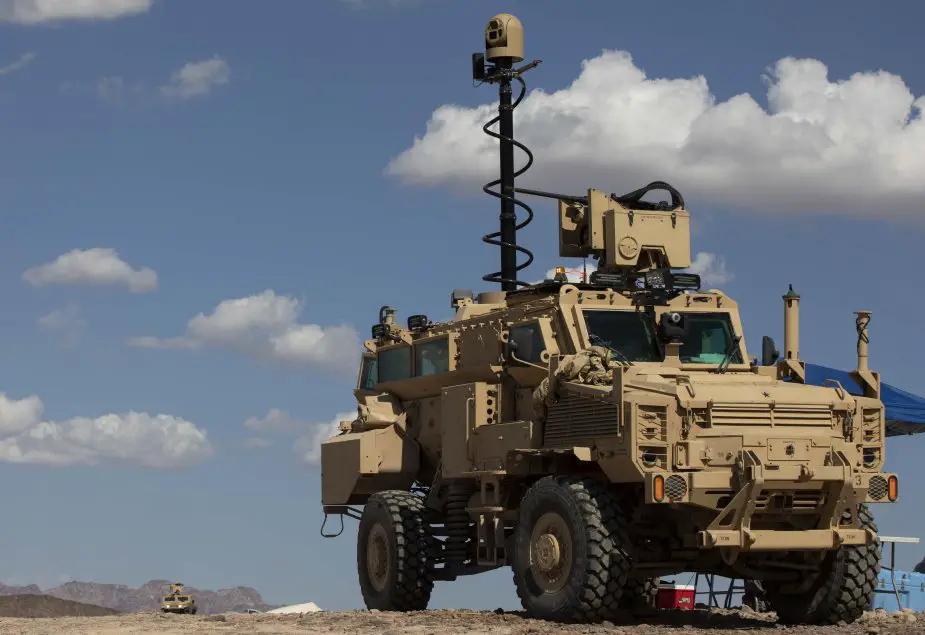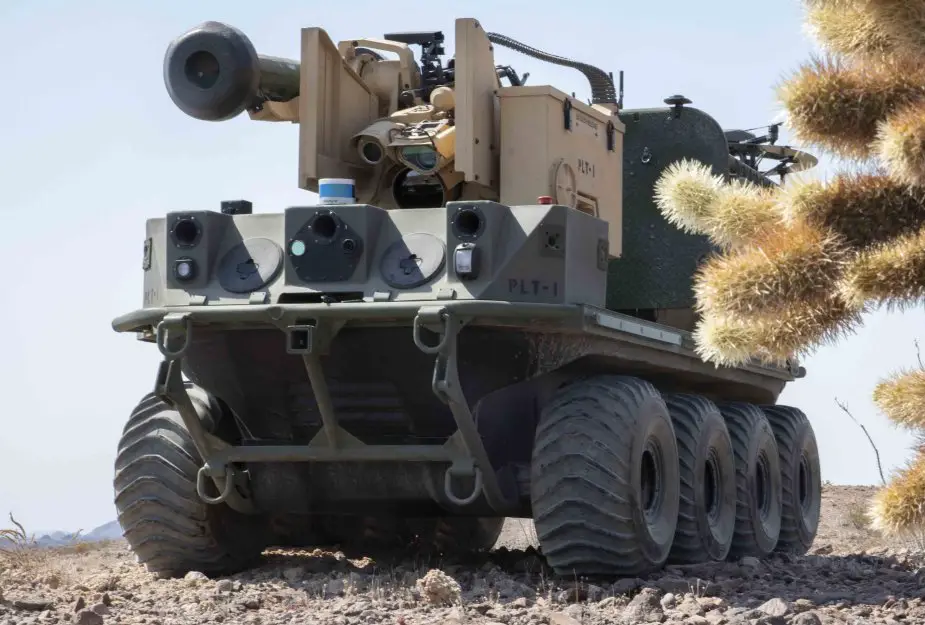Greater speed across several domains will be the key to winning future wars, U.S. Army Futures Command’s top leader said on 10 Set., as he unveiled the Project Convergence campaign. Joseph Lacdan, U.S. Army News Service, reports.
Follow Army Recognition on Google News at this link

The Next-Generation Combat Vehicle Mine-Resistant Ambush Protected surrogate conducts a live-fire exercise during the Project Convergence capstone event at Yuma Proving Ground, Arizona, Aug. 11 – Sept. 18, 2020 (Picture source: U.S. Army/Spc. Carlos Cuebas Fantauzzi)
Project Convergence, a multi-platform initiative being developed to merge joint force capabilities and keep pace with technological change, will help the Army rapidly operate across the land, air, sea, space and cyberspace domains.
“Back in the days of Desert Storm and Operation Iraqi Freedom, it was probably OK to take tens of minutes identifying the target and then actually putting rounds on the target,” Gen. John M. Murray said during a virtual media event. “But if you look at what we envision a future battlefield to look like, it's not going to be tens of minutes. When I think about a future battle, it is going to be hyperactive, and it’s going to be widely dispersed because it's going to be exceptionally lethal.”
Murray said test teams will attempt to reduce the time it takes to see and hit targets to less than 20 seconds during demonstrations Sept. 21 and Sept. 23 at Yuma Proving Ground, Arizona. The exercise runs from Aug. 11-Sept. 18.
In one of the tests, the Army plans to combine its assets with other joint assets using sensing from low-earth orbit satellites in space, sensors in the MQ-1C Gray Eagle unmanned aircraft system in the sky, and ground sensors, which will feed information to a surrogate developmental program at Joint Base Lewis-McChord, Washington. That data will then be sent to shooters on the ground at Yuma, who will fire a Howitzer or a self-propelled Howitzer artillery piece at a target. The entire demonstration should take less than 20 seconds to be successful, he said.

The autonomous system, Origin, prepares for a practice run during the Project Convergence capstone event at Yuma Proving Ground, Arizona, Aug. 11 – Sept. 18, 2020 (Picture source: U.S. Army/Spc. Carlos Cuebas Fantauzzi)
The U.S. Army is also testing three future warfare capabilities at Yuma: artificial intelligence and how it augments human senses, autonomy and robotics. Those capabilities will accelerate the pace of battle as well as boost Soldier lethality. “Those are going to be fundamental technologies that will change how we fight in the future,” Murray said of the exercise.
Project Convergence was created to implement transformational change across the Army’s modernization efforts, Murray said, in accordance with the National Defense Strategy, which states future battles will be won with speed, increased autonomy and dispersed units across degraded environments. The initiative centers around five core elements: people, command and control, weapons systems, terrain, and information. Convergence, a core tenet of the multi-domain operations concept, combines development efforts across each element of the joint force from the tactical to strategic level to achieve greater lethality.
Much of AFC will participate in the multi-unit exercise and demonstrations including the Army’s AI Task Force and the Future Vertical Lift, Network, Next-Generation Combat Vehicle, and Assured Positioning, Navigation and Timing Cross-Functional Teams. Other demonstrations will continue in 2021 with the Air and Missile Defense, Soldier Lethality, and Synthetic Training Environment CFTs.
During the Sept. 21 and Sept. 23 demonstrations, participants will use a two-sensor, two-shooter, two-target format to demonstrate specific threads within an artificial “kill web.” The demonstrations will form the groundwork for establishing a basic blueprint for artificial intelligence at the tactical edge for brigade-sized formations and below.
“How do you start to combine and connect all these things so they interoperate? It's bigger than just the [signature weapons systems],” Murray said. “It’s artificial intelligence. It’s machine learning. It’s the network that will support all that. It's autonomy, it's robotics, and it's really the underlying data architectures and how we manage data, because when you boil it right down, it all comes down to how you manage that data.”
In the two-two-two format, participants must track targets at different ranges and angles, creating a more complex battle simulation similar to what Soldiers may face on a future battlefield. It could also better determine which capabilities can engage adversaries with the highest probability of success.
“We have to learn from the technology demonstrations how we're going to have to change how we fight and how we organize for that future fight,” Murray said.
During the project’s month-long exercise, the AI Task Force will conduct a demonstration of a team of air and ground sensors that use AI and machine learning to track and detect targets.

An engineer with Robotic Research LLC, conducts a test run of the autonomous system Pegasus, during the Project Convergence capstone event at Yuma Proving Ground, Arizona, Aug. 11 – Sept. 18, 2020 (Picture source: U.S. Army/Spc. Carlos Cuebas Fantauzzi)
Thermal sensors and electro-optical sensors will be used to identify and locate the targets through dense terrain, which the team will then report to the Android Tactical Assault Kit. Participating air and ground vehicles will be given waypoints to find directions to the ATAK, but in 2021 the sensors will collaboratively search a zone during reconnaissance.
During the demonstrations, forces will exchange combined arms data to expedite the decision making while applying lethal effects, and CFTS will synchronize to show the full modernization effort. Additionally the AI and network lethality capabilities will support requirements development, Murray said.














